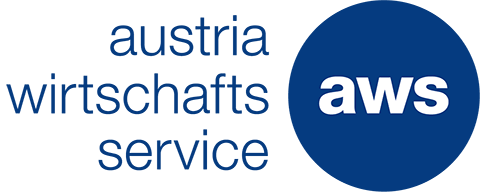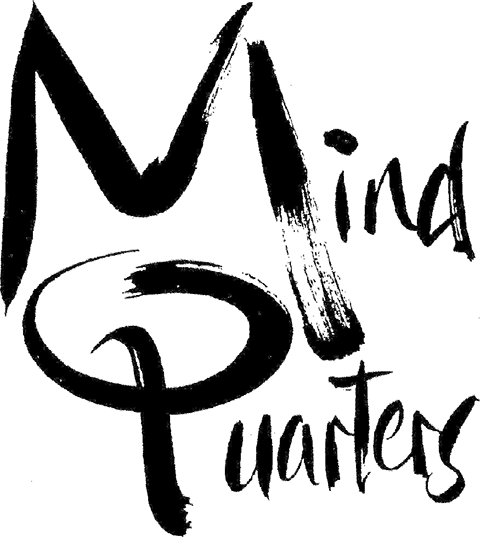English: ‘centennial washing machine’ or ‘centenarian washing machine’
-
 December 6, 2022One of our experimental setups are exhibited at the Deutsches Technikmuseum BerlinWe feel very privileged to be part of the special exhibition “Repair!”. Runni...
December 6, 2022One of our experimental setups are exhibited at the Deutsches Technikmuseum BerlinWe feel very privileged to be part of the special exhibition “Repair!”. Runni... -
 October 30, 2020Two of our experimental setups are exhibited at the Vienna Technical MuseumWe feel very honored to say, that VAB5 and VAB7 are exhibited under the same roof as Hein...
October 30, 2020Two of our experimental setups are exhibited at the Vienna Technical MuseumWe feel very honored to say, that VAB5 and VAB7 are exhibited under the same roof as Hein... -
 April 28, 2020Talk at Vienna Design Week 2019 available as podcastVienna Design Week’s team just released our talk from last year as a podcast!https:...
April 28, 2020Talk at Vienna Design Week 2019 available as podcastVienna Design Week’s team just released our talk from last year as a podcast!https:... -
 April 3, 2020aws Creative Impact grantedVery good news! The Austria Wirtschaftsservice (aws) today granted the aws creative impac...
April 3, 2020aws Creative Impact grantedVery good news! The Austria Wirtschaftsservice (aws) today granted the aws creative impac... -
 November 8, 2019POTENTIALe FeldkirchMeet us at the POTENTIALe Feldkrirch on Sunday, 10. November from 2p.m. – 5p.m. in the &#...
November 8, 2019POTENTIALe FeldkirchMeet us at the POTENTIALe Feldkrirch on Sunday, 10. November from 2p.m. – 5p.m. in the &#... -
 November 8, 2019Original MagazinOur experimental setup #8 is featured on the cover of issue #23 of the “Original Ma...
November 8, 2019Original MagazinOur experimental setup #8 is featured on the cover of issue #23 of the “Original Ma... -
 September 12, 2019Vienna Design Week 2019See the current state of our development at the Vienna Design Week 2019 in Festival Headqu...
September 12, 2019Vienna Design Week 2019See the current state of our development at the Vienna Design Week 2019 in Festival Headqu... -
 June 6, 2019AK für SieThe Austrian Chamber of Labour featured our project in the June issue of their monthly mag...
June 6, 2019AK für SieThe Austrian Chamber of Labour featured our project in the June issue of their monthly mag... -
 May 4, 2019Die PresseThe daily newspaper “Die Presse” featured our project in their issue on Saturd...
May 4, 2019Die PresseThe daily newspaper “Die Presse” featured our project in their issue on Saturd... -
 April 27, 2019Maker Faire Vienna 2019Meet us on 4. & 5. May 10:00 – 18:00 at the Maker Faire Vienna 2019, the biggest DIY f...
April 27, 2019Maker Faire Vienna 2019Meet us on 4. & 5. May 10:00 – 18:00 at the Maker Faire Vienna 2019, the biggest DIY f... -
 April 26, 2019Distributed Design AwardVery good news! Today we got nominated for the Distributed Design Award as part of the Mak...
April 26, 2019Distributed Design AwardVery good news! Today we got nominated for the Distributed Design Award as part of the Mak... -
 February 12, 2019170. UXvienna Evening MeetupSustainable devices also need good user interfaces. In the keynote 'Promoting use cases & ...
February 12, 2019170. UXvienna Evening MeetupSustainable devices also need good user interfaces. In the keynote 'Promoting use cases & ... -
 December 19, 2018aws impulse XS grantedExcellent news! The Austria Wirtschaftsservice (aws) today granted the aws impulse XS supp...
December 19, 2018aws impulse XS grantedExcellent news! The Austria Wirtschaftsservice (aws) today granted the aws impulse XS supp... -

-

-
 November 26, 2018UX Night Vienna 2018Sustainable devices also need long lasting user interfaces. In the keynote 'User Interface...
November 26, 2018UX Night Vienna 2018Sustainable devices also need long lasting user interfaces. In the keynote 'User Interface... -
 May 6, 2018Thank You!The Maker Faire Vienna 2018 on 5. & 6. May was great! Many thanks to everyon...
May 6, 2018Thank You!The Maker Faire Vienna 2018 on 5. & 6. May was great! Many thanks to everyon... -
 May 5, 2018Radio WienOur project was featured in the news at 8:00 on Radio Wien. http://wien.orf.at/radio/
May 5, 2018Radio WienOur project was featured in the news at 8:00 on Radio Wien. http://wien.orf.at/radio/ -
 May 5, 2018ORF WienOur project was featured on ORF Wien. http://wien.orf.at/news/stories/2911006/
May 5, 2018ORF WienOur project was featured on ORF Wien. http://wien.orf.at/news/stories/2911006/ -
 May 4, 2018FuturezoneOur project was featured in an article online on futurezoneand also in the print version o...
May 4, 2018FuturezoneOur project was featured in an article online on futurezoneand also in the print version o... -
 May 2, 2018Maker Faire Vienna 2018Meet us next weekend at the Maker Faire Vienna 2018at booth E46! https://www.makerfairevie...
May 2, 2018Maker Faire Vienna 2018Meet us next weekend at the Maker Faire Vienna 2018at booth E46! https://www.makerfairevie... -
 November 27, 2017TV documentary 'Geplanter Murks'Our project was featured on TV in ‘Geplanter Murks’, a documentary by Anna Kat...
November 27, 2017TV documentary 'Geplanter Murks'Our project was featured on TV in ‘Geplanter Murks’, a documentary by Anna Kat...
About
Sustainable consumption and production patterns demand maximization of resource efficiency over their entire life cycle.
The goal of the registered association Permanere is to research and develop sustainable products and solutions.
Since 2017 the team, consisting of Peter Knobloch, Daniel Kloboucnik, Bernhard Ranner, and Billie Rehwald, is developing a resource efficient washing machine with competitive performance that can be used for 100 years and at least as long repaired.
Its design focuses entirely on maximizing service life, ease of maintenance & repair, and the availability of spare parts for all individual components.
Technical boundaries
Fundamental laws of physics and chemistry limit the continuous development of products and can only be approached to a certain extent.
Since the first automatic washing machine for households in 1937, the minimization of the purchasing costs (determinated by the design) and the operating costs (due to the water and energy requirements) have always been goals of the continuous development of all manufacturers.
Most of the energy required by a washing machine is used for heating up the water. It is determined by the laws of physics: the temperature increase of 1 liter of water by 1 degree Celsius always requires 1.16 watt-hours. This means that the energy requirement is primarily determined by the hot water quantity and temperature.
The achieved washing performance depends not only on the temperature but also on the mechanics, chemistry and washing duration. A reduction of the energy consumption by lowering the water temperature can be compensated, within a certain limit, by an elongation of the washing time or a corresponding detergent (“Sinner’s Circle”).
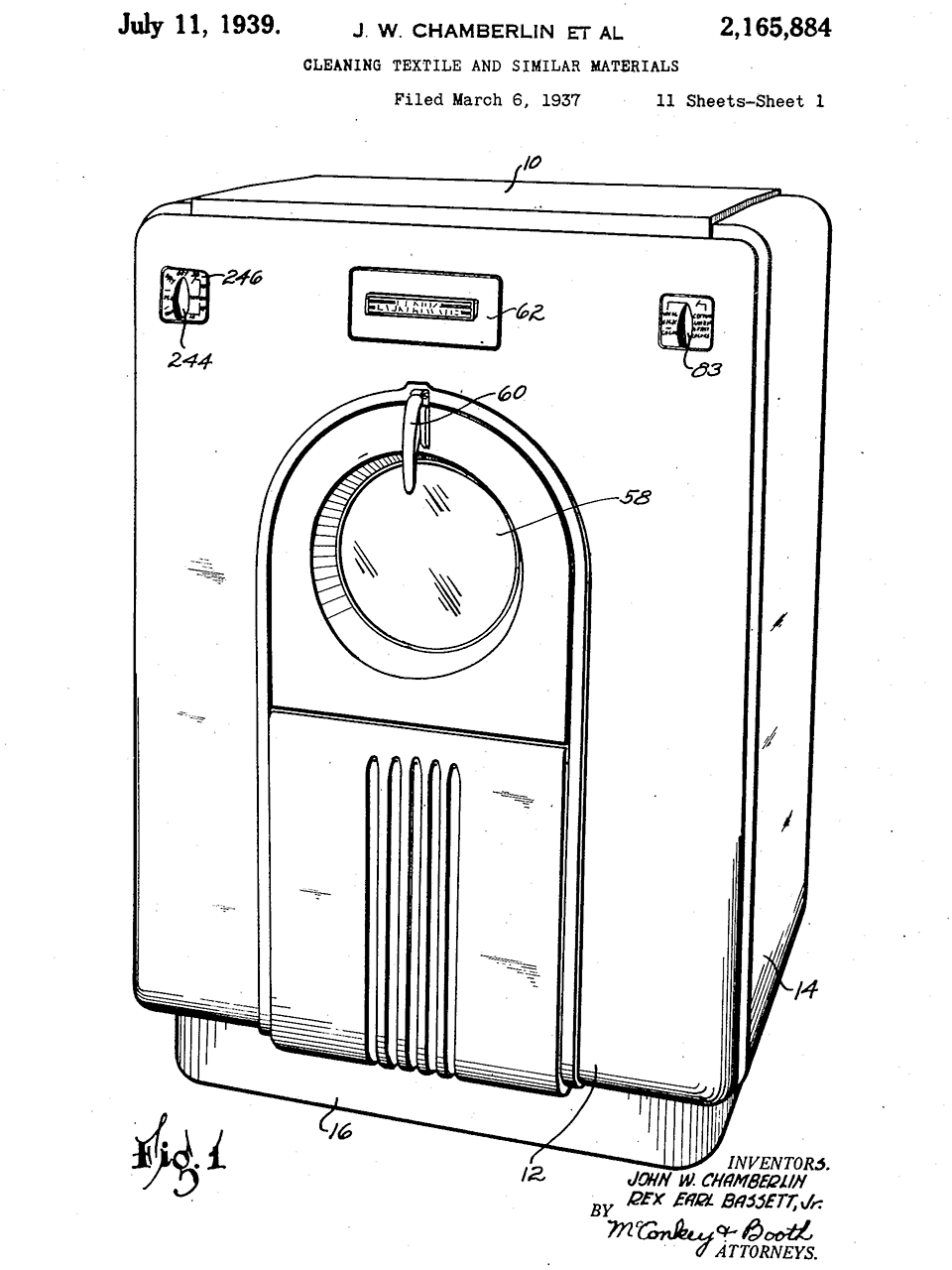
1937: First automatic washing machine “Bendix Home Laundry”
© Bendix Home Appliances
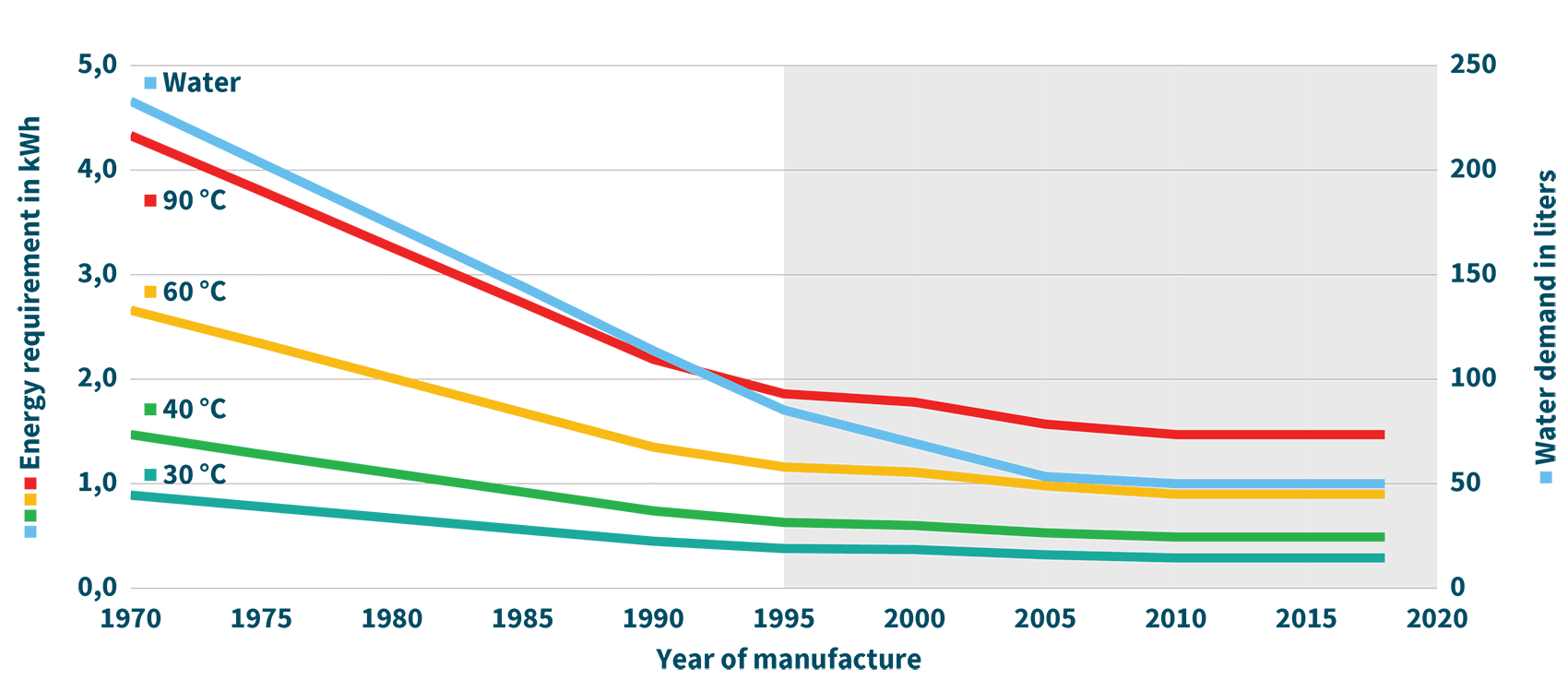
Development of energy and water consumption per wash cycle
Source: Own illustration based on IKW (2019) Sustainability in the washing, care and cleaning agent industry in Germany
Until the mid-1990s, a reduction in the energy and water requirements per wash can be observed. The clear flattening of the curves from this point on indicates that the technical limits for washing machines have already been reached.
Maximization of service life
To improve the sustainability of a product, it is necessary to reduce the total resource requirements per use.
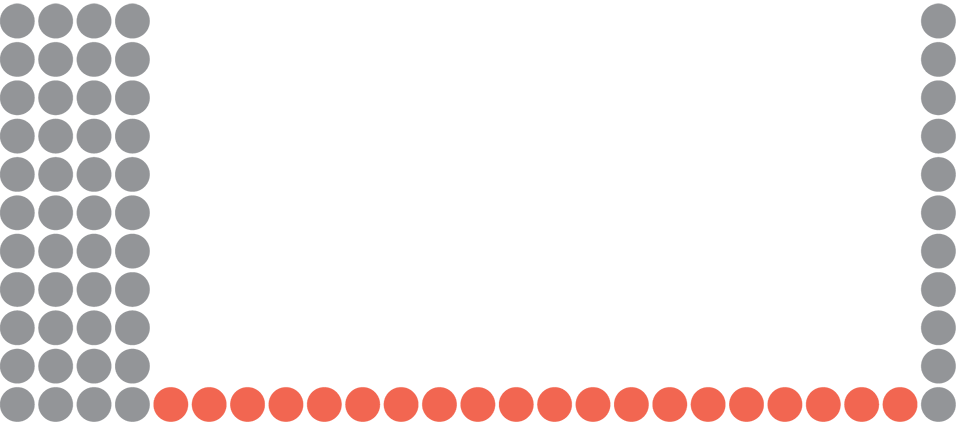
Total resource requirements
The life cycle of a product consists mainly of three phases: Production, use, recycling & disposal. A washing machine requires about 1.9 tons of natural resources in its production.
In order to assess the sustainability of a product, the expense of production, recycling and disposal must be attributed to the use phase.
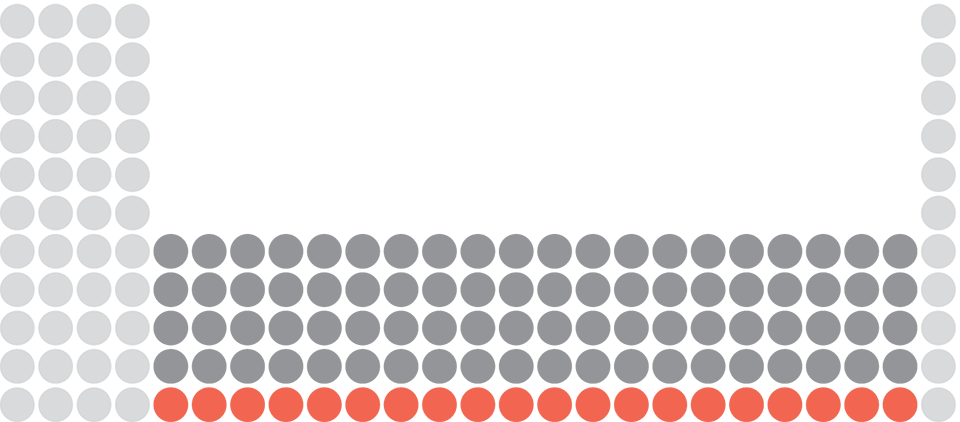
Resource requirements per use
A simple option to reduce the resource requirements per use is to design the machine for longevity, maintainability, and reparability.
For products where the technical limits have already been reached, this is often the most effective option.

Reduced resource requirements per use by extending the service life
The publicly accessible repair manuals and stocking of spare parts can improve the service life even without changing the design and be an important purchase decision when buying new ones.
Digital spare parts storage
By aligning the design with digital manufacturing processes, it is possible to produce replacement parts as needed.
Digital manufacturing processes differ from all others in the aspect, that the shapes of the parts to be produced are available exclusively as digital data, which are used directly to control machine tools. As a result, the production costs of individual pieces are low, compared to industrial processes that require a costly mold and are only economical for high quantities.

Reibungsdämpfer, CNC lasergeschnitten
Required:
Manufacturing processes that are economically applicable even in small quantities, e.g.
— CNC milling & turning
— CNC laser cutting
— CNC punching & nibbling
— CNC bending
— All 3D printing processes
Additionally possible:
Manufacturing processes that require costly tool making, e.g.
— Injection moulding
— Punching
— Deep drawing of sheet metal
Local service providers act as producers for repair shops because of the resulting digital spare parts storage.
TEAM
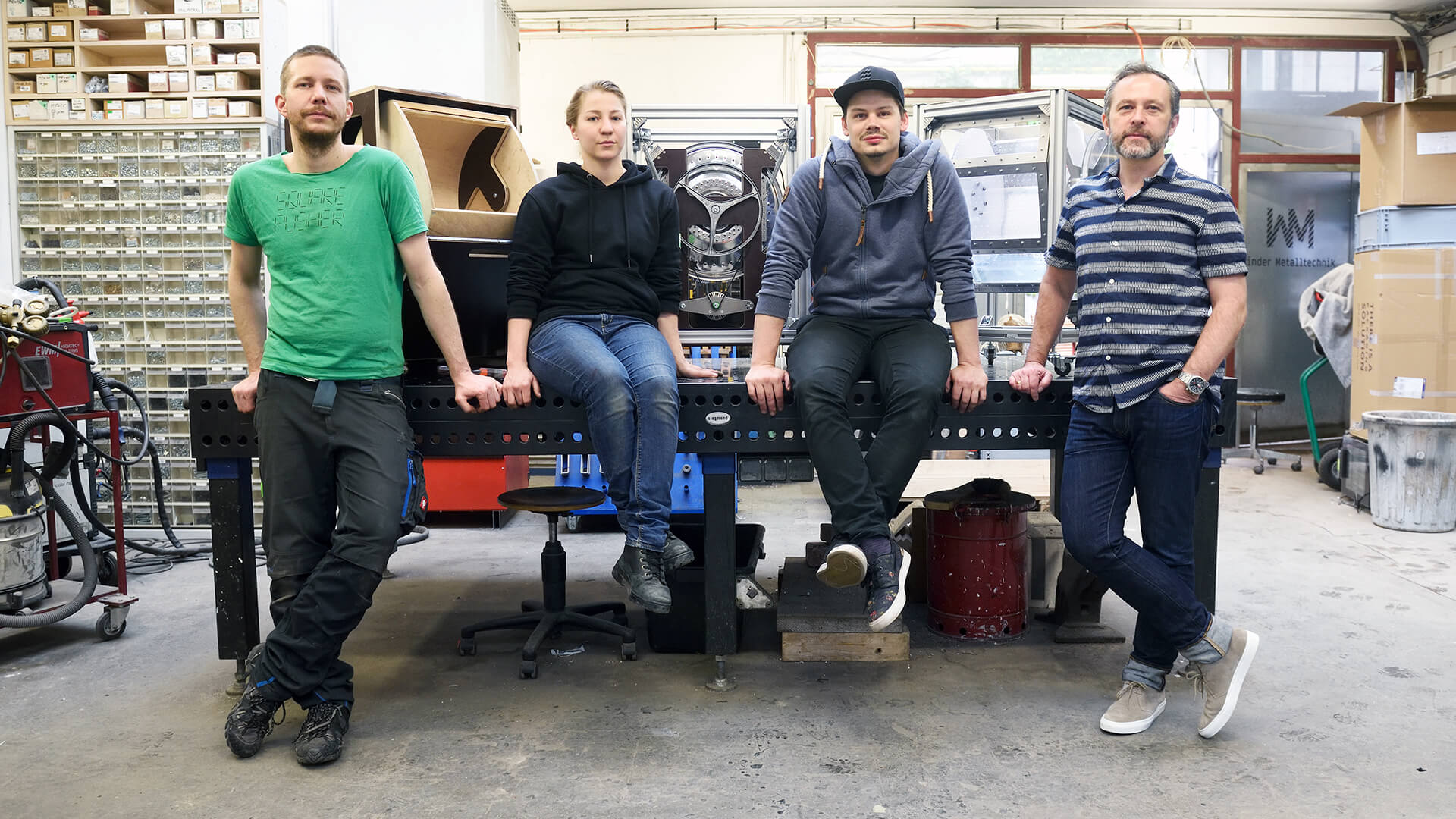
Bernhard Ranner
Der ProtoTypBillie Rehwald
Freelance designerFreelance designer
Peter Knobloch
DeveloperContact
Permanere – Verein zur Erforschung und Entwicklung nachhaltiger Produkte und Lösungen
Lerchenfelder Straße 78-80/10
1080 Vienna
Austria
Central association register number: 1428087425
Email: hello@permanere.org
100jährige Waschmaschine – proof of concept: funded by aws impulse XS of the BMDW handled by the aws


